In my last blog, The 1st Grader Version of Equine Limb Anatomy, I discussed the origins of the equine limb. In this blog, let’s look at the functions of the legs and feet. Legs have several “bends” in them to absorb the shock of landing impact, tense and spring upward to propel a body in movement. In humans, we have an ankle that takes the first impact and cushions or absorbs the impact of our foot landing, then we have a knee, then a hip and, eventually, the whole body frame can react and compensate for the impact of the feet.
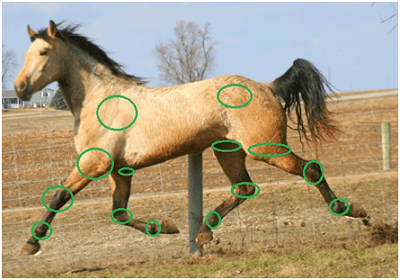
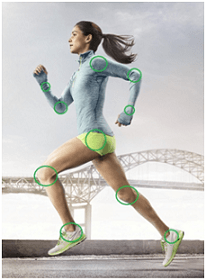
In cats, dogs, horses, etc. you see the similar leg structures: multiple points that bend to spread out the shock of impact on multiple locations, and also, multiple sets of muscles to propel the body in continuous movement.
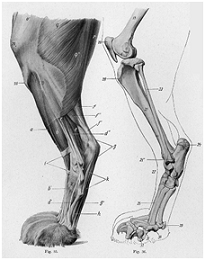
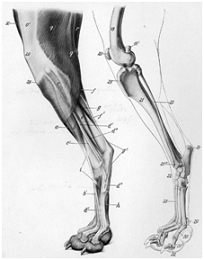
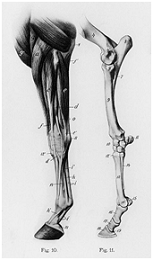
If I had to design a foot, I would need it to absorb impact, have the ability to grip, have the ability to brake and have launching power.
Cats and dogs have claws to help them for traction and launching. If you’ve had your dog chase the cat around the living room, you undoubtedly heard the traction control kick in as they rounded a corner on your carpet. They have a large, central pad for absorbing the landing shock. You can see their pad is the support beneath the “column” that is their leg. When you look at the skeleton view, you can tell that the pad was designed to take those near-vertical lower leg bones and cushion them. Their foot can expand and grip the ground which also helps with traction, braking and maneuverability.
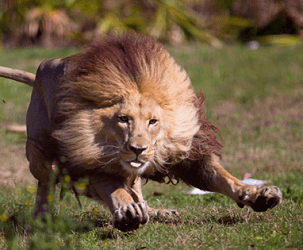
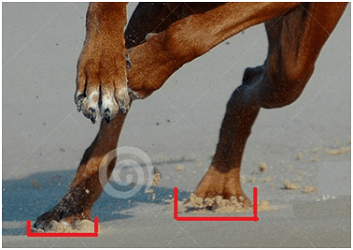
What about horses? Where is their “central pad cushion”? Where is their flex? Where is their “claw” for traction and maneuverability?
Let’s take a look at the foot of a horse. Now, when we looked at the side view of the cat and dog legs, we could clearly see there was room for a pad or cushion. Horses actually have room for one too. Their bottom bone is shaped like a croissant or a half moon.

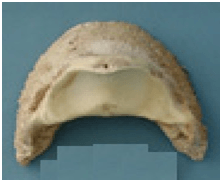
However you want to look at it, there is a hollow. I put hooves next to the view of the bone so you can see which angle we are looking at. The first are eye level, from the front and the back. You can see the hollow.

And from the solar view and topical view, you can see the crescent shape and, additionally, where the hollow is.
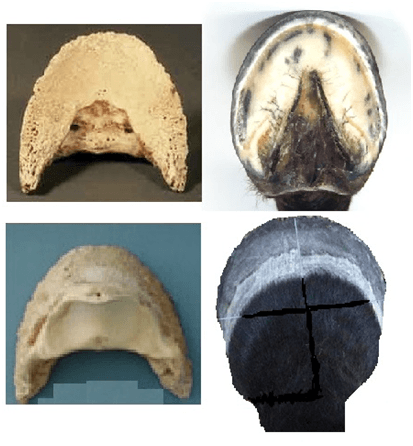
At the bottom of the leg is a cluster of bones, just like in cats, dogs and humans. It has a hollow. You can see additional bones of the foot here, as well as another angle of the hollow.
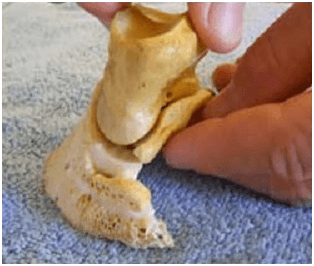
Here is a view of that bone slid into a hoof capsule. See all that room? What goes in there?

It’s the digital cushion. “Digital” means of a Digit. A finger, toe or “very most end of a limb” is considered the “digit”. Digits also refer to numbers. Funny enough, digit comes from the Latin word digitus meaning finger or toe, with the additional meaning that you normally “counted” on your “fingers”.
So back to Mr. Pony Toe. A Digital Cushion is, quite literally, a cushion for his toe. It looks gross and feels slimy and awesome in person. If Silly Putty and Memory Foam had a lovechild with the surface texture of eyeball goo, it would be a digital cushion.
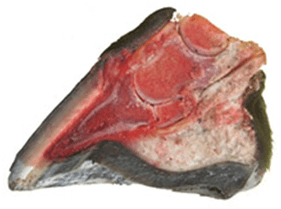
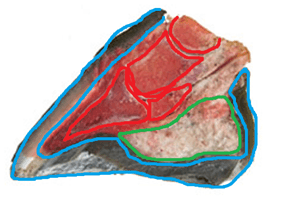
On the left is a hoof in cross-section. The right is the same hoof, marked. I outlined the bones in red. I outlined the outer wall of the entire hoof and fur in blue (“external”, if you will). The green portion I outlined is the digital cushion. It’s big, it’s squishy, it’s slimy. If we rotated it around to see it from the back, you would see it fully wraps around the back end of the hollow of the coffin bone and sits as a cushion under the “column” of the leg structure. Below, you can see the back of a hoof, in the flesh (no pun intended), then the next layer deep, being able to see the digital cushion, then one more layer deep, seeing the back of the naked coffin bone.

Below, you can see two digital cushions, side by side. In some horses it is not as well developed or “big” and cushions less. All of the health of the hoof is related, one piece to the next. The adage “use it or lose it” seems to apply to the digital cushion. With the health of the whole foot taken into consideration, you can see that the foot on the below left is in poorer shape. The digital cushion isn’t supporting the bone structure. In fact the foot looks pretty flat, with the bones looking pretty close to the ground. While the foot on the bottom right shows a large cushion and a larger buffer between the bone and the ground.
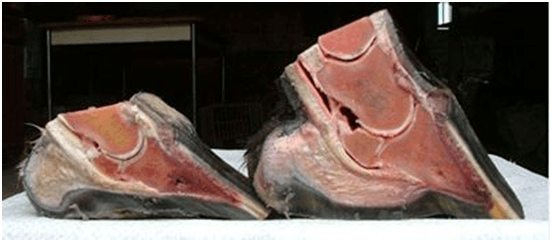
Stay tuned for next the next installment, Functions Part II: The Hoof is a Roller Blade and a Nike.
Holly Jonsson

Director of Sales
Through a lifetime of “horse crazy” and the fortunate experience of riding nearly every shape and size of horse, I got to see a wide array of hoof shapes and sizes. No Hoof, No Horse is very true to me. I want to ensure that horses on every continent have a variety of footwear to pick from, to ensure the best match is found. I want your partner to be happy from the ground up!




